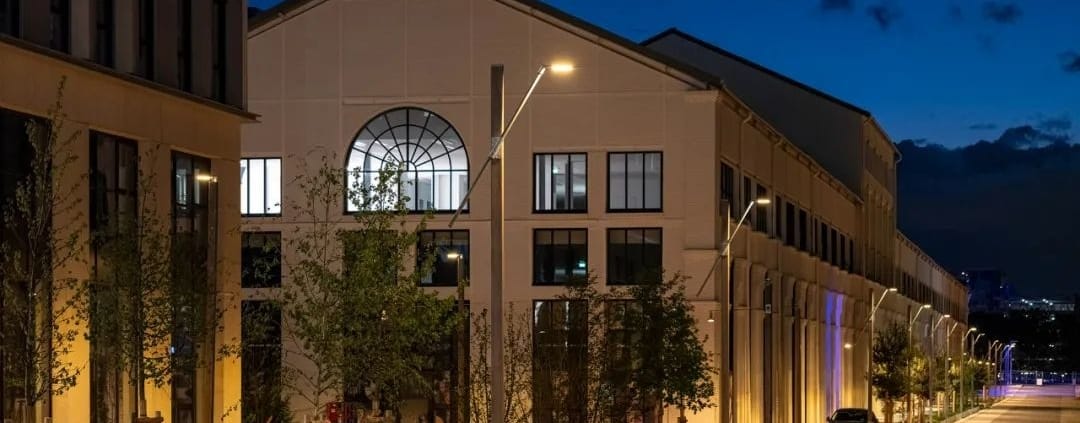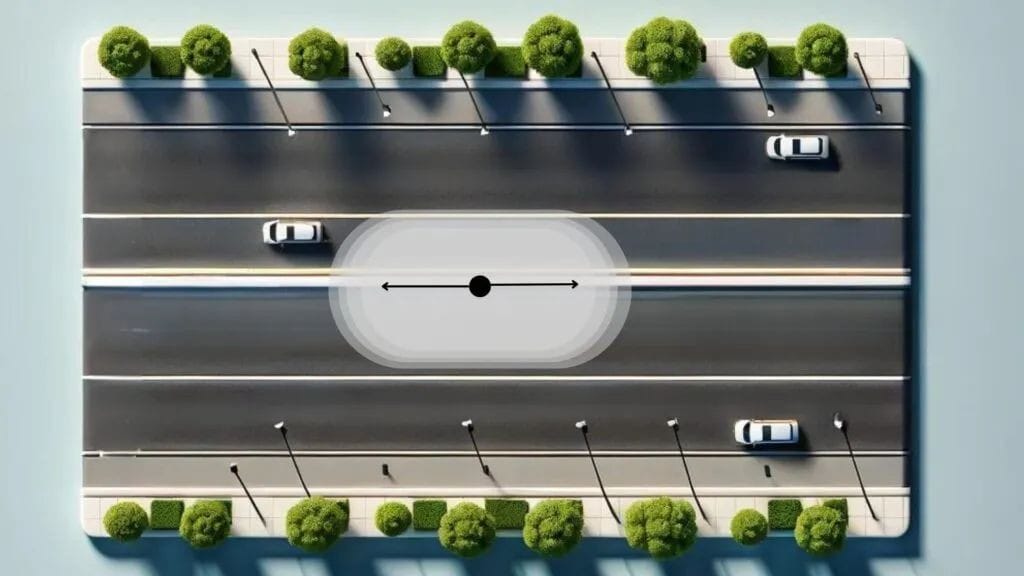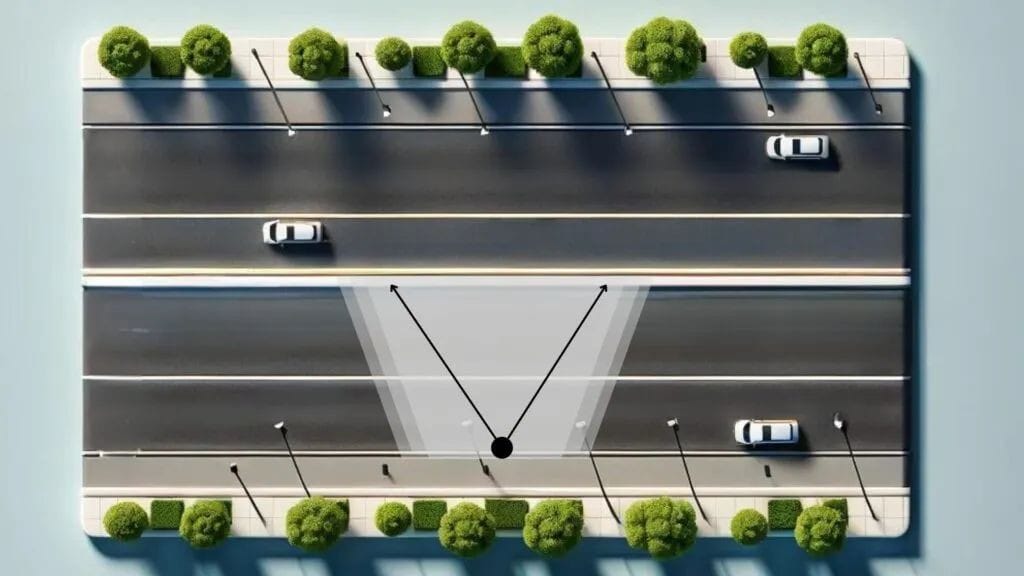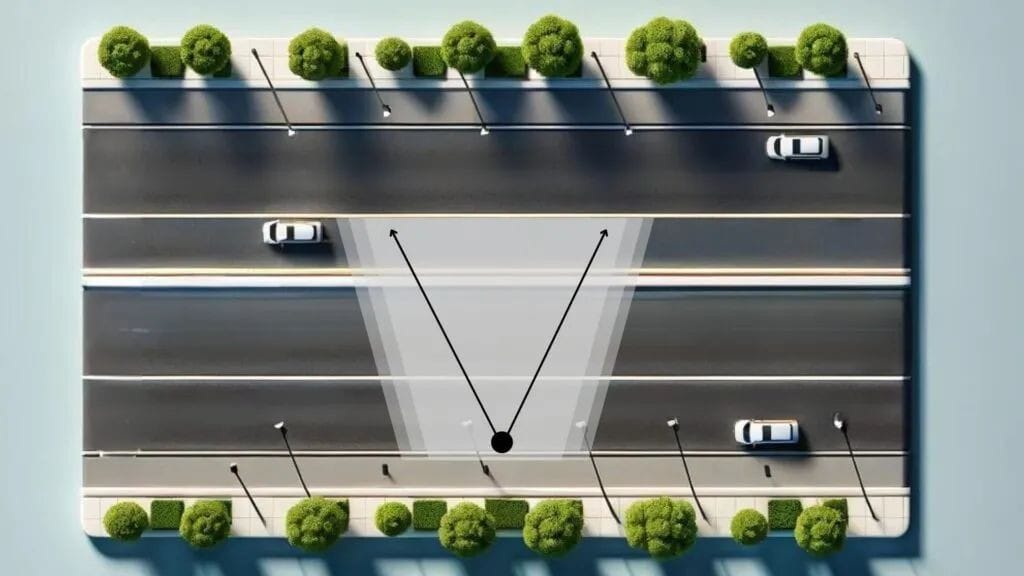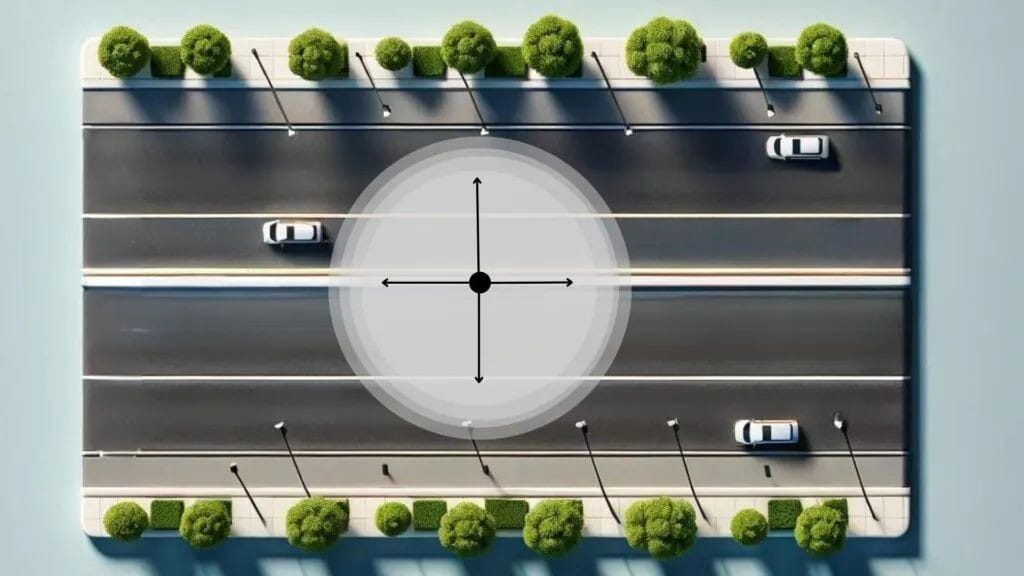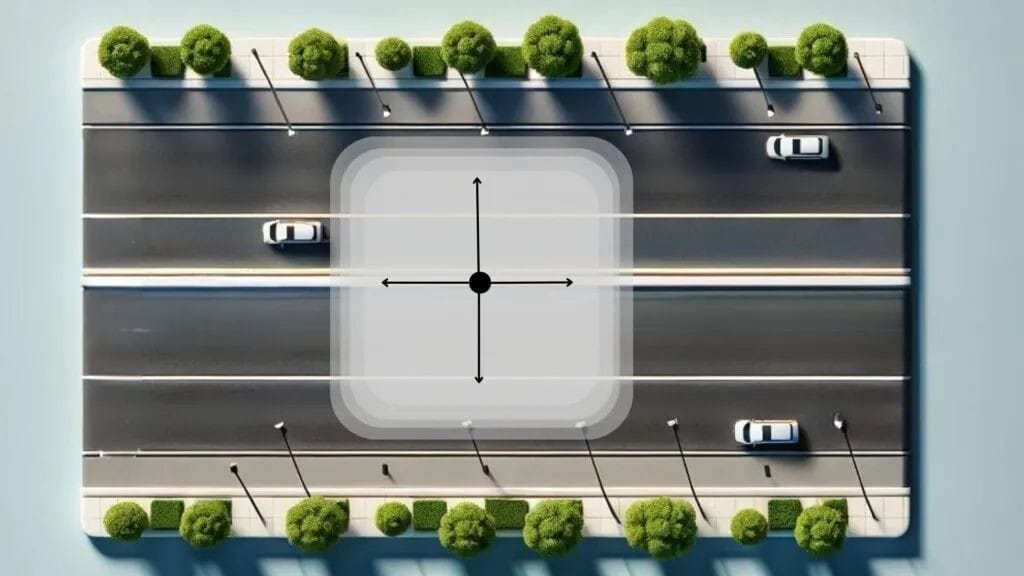都市道路照明の根底にあるロジック:光がどのように、なぜ、どこで照らされるのかを理解する
1. Introduction
Outdoor lighting design is a complex discipline that surpasses simple spatial illumination; it profoundly influences public safety, visual comfort, energy consumption, and the natural environment. Precisely controlling and distributing light is key to achieving these multifaceted goals. This article aims to provide a comprehensive analysis of key light distribution concepts—particularly cutoff fixtures (including full cutoff, cutoff, and semi-cutoff), non-cutoff fixtures, and batwing distributions—while strictly comparing them to established standards for street lighting in North America (primarily defined by the Illuminating Engineering Society of North America (IESNA)). By dissecting the technical definitions, characteristics, and typical applications of each type, this article will clarify the distinctions and synergies between them, offering valuable insights for professionals in urban planning, civil engineering, and lighting design to develop sustainable, compliant, and high-quality outdoor lighting solutions.
2. Understanding Cutoff Classification of Fixtures
The cutoff classification of fixtures defines the extent to which light is emitted above the horizontal plane, playing a crucial role in managing light pollution, glare, and light trespass. These classifications, historically defined by the Illuminating Engineering Society (IES), provide a framework for controlling upward light emissions.
2.1. Full Cutoff Fixtures
The light distribution of full cutoff fixtures is defined by two strict standards: first, the light intensity (candelas) at the nadir (directly below) at 90 degrees or above is zero, indicating that the fixture does not emit any light directly upwards 1. Second, the candela value at a vertical angle of 80 degrees or above per 1000 lumens of bare lamp does not exceed 100 (i.e., 10%) 1. These limits apply to all lateral angles around the fixture.
Full cutoff fixtures are designed to direct all light downward, thereby effectively minimizing skyglow (the brightening of the night sky) and light trespass (unwanted light spilling onto adjacent properties) 5. This characteristic makes them key to complying with dark sky regulations and preserving nighttime environments. Additionally, by strictly controlling high-angle light, they significantly reduce direct glare, enhancing visual comfort and safety for drivers and pedestrians 6. Their efficiency at precisely directing light only where illumination is needed also assists in energy conservation 6. Thus, many local regulations and environmental standards across North America mandate or strongly recommend the use of full cutoff fixtures 5.
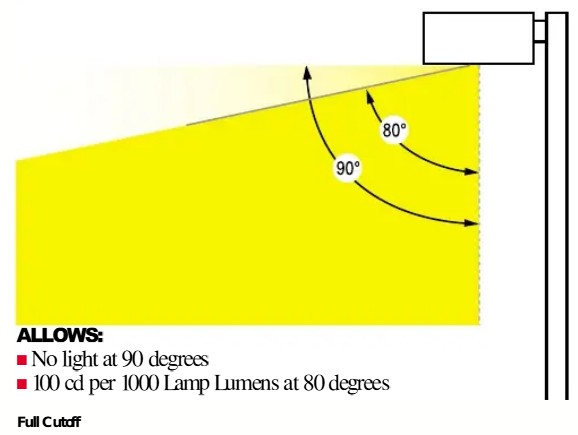
2.2. Cutoff Fixtures
The light distribution of cutoff fixtures is defined by specific candela limits: the candela value at a vertical angle of 90 degrees does not exceed 25 (2.5%) 2. At the nadir, the candela value at a vertical angle of 80 degrees does not exceed 100 (10%) 2. These limits apply to all lateral angles. While a small amount of light is allowed above 90 degrees, cutoff fixtures still significantly control upward light compared to semi-cutoff or non-cutoff fixtures, thereby assisting in reducing light pollution.
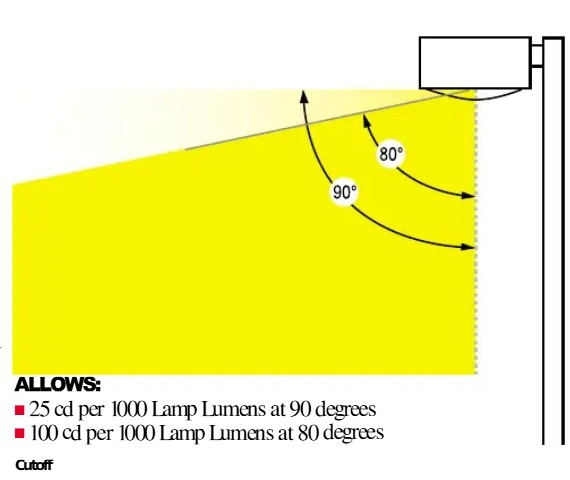
2.3. Semi-Cutoff Fixtures
Semi-cutoff fixtures have looser restrictions on upward light: the candela value at a vertical angle of 90 degrees does not exceed 50 (5%) 2. At 80 degrees, the candela value does not exceed 200 (20%) 2. These limits apply to all lateral angles. Compared to full cutoff or cutoff fixtures, semi-cutoff fixtures emit more light at high angles, increasing the potential for glare and skyglow. They are generally not recommended for environmentally sensitive areas or situations requiring strict control of light pollution.
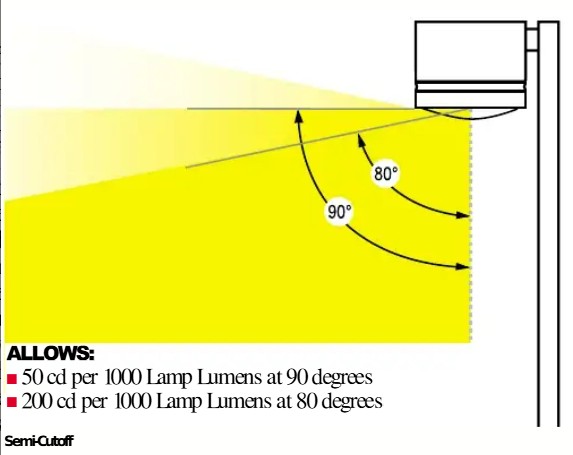
2.4. Non-Cutoff Fixtures
Non-cutoff fixtures are characterized by the absence of light intensity (candelas) restrictions above their maximum candela region 2. These fixtures emit light in all directions, including significant amounts directly upwards and horizontally. This lack of control leads to severe light pollution (skyglow), substantial light trespass into adjacent properties, and often produces uncomfortable glare 9. Due to growing environmental concerns and regulatory efforts to control light pollution, their use is increasingly restricted or prohibited in many jurisdictions 6.
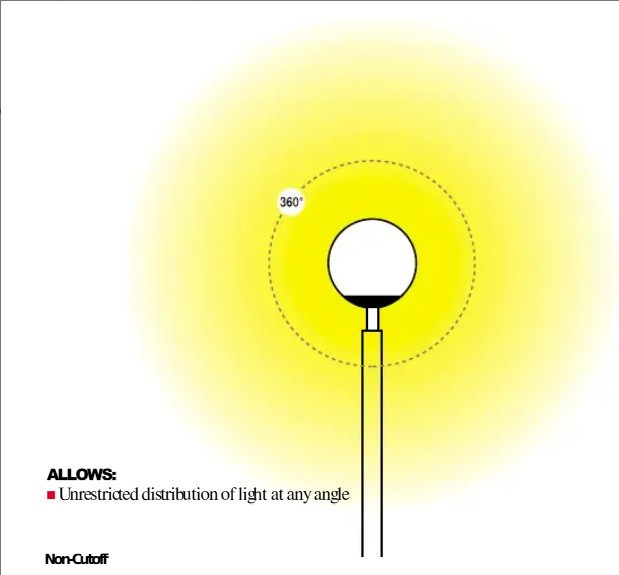
The evolution from non-cutoff to full cutoff fixtures represents a thoughtful advancement in lighting engineering and regulatory framework aimed at mitigating the negative impacts of outdoor lighting. This trend emphasizes the growing importance of environmental responsibility and enhancement of visual quality in modern lighting design. Unrestricted light (characteristic of non-cutoff fixtures) leads to issues such as glare, light spillage onto adjacent properties, and widespread light pollution 9. Conversely, stricter cutoff classifications, like full cutoff, are engineered to address these issues, aiming to “reduce light pollution,” “minimize skyglow,” “reduce glare,” “enhance visual comfort,” and “increase energy efficiency” 5. This evolution in classification is a direct response from the industry and regulatory bodies (such as the International Dark-Sky Association and IES RP-33) to the recognition of light pollution and glare as significant issues, driving and establishing stricter standards to promote more responsible and sustainable lighting practices. It indicates that lighting design has shifted from merely providing illumination to offering “high-quality” lighting that considers its broader environmental and human impacts.
It is noteworthy that the traditional cutoff classification system is being replaced by the BUG (Backlight-Uplight-Glare) rating system 3. This transition marks a movement towards a more detailed, comprehensive, and actionable approach to assessing lighting performance, recognizing that uplight is only one component of light pollution and trespass. The traditional cutoff system primarily focuses on the emission of light at angles above 80° and 90° (uplight). However, the BUG rating divides spherical light distribution into three different zones: “Up,” “Front,” and “Back,” quantifying the amount of light in each zone 3. This means it evaluates not only uplight but also light spill to the back (backlight, leading to trespass) and glare (light emitting at high angles forward and potentially causing discomfort). This shift illustrates that controlling uplight, while important, is insufficient for achieving truly comprehensive and responsible outdoor lighting. Backlight can lead to significant light trespass onto nearby properties, and glare directly affects visual comfort and safety. The BUG rating offers a more comprehensive and nuanced framework for designers and regulators to address all major forms of light pollution and disturbances. This allows for more precise selection and design of fixtures, leading to better overall lighting quality, enhanced safety, and improved environmental management through a transition from a simple pass/fail system to a graded, multi-dimensional assessment.
Table 1: Comparison of Cutoff Fixture Classification Characteristics
Classification Type | Candela Limit at 90° (per 1000 bare lamp lumens) | Candela Limit at 80° (per 1000 bare lamp lumens) | Primary Features / Uplight Control | Relevant Impacts |
Full Cutoff | 0 1 | Not exceeding 100 (10%) 1 | Zero uplight | Excellent dark sky compliance, minimal glare, minimal light pollution |
Cutoff | Not exceeding 25 (2.5%) 2 | Not exceeding 100 (10%) 2 | Very little uplight | Good glare control, reduced skyglow |
Semi-Cutoff | Not exceeding 50 (5%) 2 | Not exceeding 200 (20%) 2 | Moderate uplight | Potential for glare and light trespass |
Non-Cutoff | Unrestricted 2 | Unrestricted 2 | No uplight restrictions | High risk of light pollution and glare |
3. Batwing Distribution
Batwing distribution represents a unique optical design strategy aimed at optimizing light quality and uniformity within the illuminated area. Unlike cutoff classifications that control uplight or the IESNA types that define the overall shape of light on surfaces, batwing distribution focuses on the uniformity of illumination.
3.1. Definition and Unique Profile
Batwing distribution is characterized by its ability to produce exceptionally uniform light output over a wide beam angle range 12. Its name “batwing” derives from the unique light intensity profile shape which resembles a bat’s wings when plotted on a polar graph, showing two peaks of intensity on either side of the nadir 12.
This unique distribution is typically achieved through the integration of specially designed diffusers or advanced optical elements within the fixture. These optical components work by breaking down the light emitted from LED sources into a series of small, evenly spaced beams. This engineered diffusion process transforms the more common “hotspot” distribution (where light is brightest in the center and fades quickly towards the edges) into a significantly more uniform light output 12. Additionally, some batwing designs utilize optical films to achieve “double-angle-bent light intensity” to meet specific illumination needs 13.
3.2. Advantages and Applications
Batwing distribution has several significant advantages over traditional light patterns:
More uniform light output: It ensures consistency in illumination levels across the entire beam angle range, minimizing changes in brightness and reducing the occurrence of dark spots 12.
Reduced hotspots: By eliminating concentrated areas of light, batwing distribution alleviates visual discomfort and creates a more aesthetically pleasing lighting environment 12.
Improved visual comfort and glare-free environment: The even distribution of light significantly reduces strong contrasts and direct glare, providing users with a more comfortable and ergonomic visual experience 12.
Increased productivity and mood: Studies show that comfortable, glare-free, and uniform lighting environments can positively influence user productivity and overall well-being across various settings such as offices, retail spaces, classrooms, and libraries 12.
Batwing distribution is an excellent choice for a wide range of applications requiring uniform, glare-free conditions:
Commercial and industrial spaces: Offices, retail environments, classrooms, and libraries benefit from shadow-free and hotspot-free lighting, enhancing focus and reducing eye strain 12.
Residential lighting: It helps create a more comfortable and warm atmosphere in homes.
Indirect lighting: Particularly effective when used with suspended indirect fixtures, light is directed to the ceiling to indirectly illuminate the space. This creates a broad, uniform pattern of reflected light, further enhancing uniformity and reducing direct glare 12.
Batwing distribution is an optical design feature that can be integrated into fixtures rather than being an independent classification system like cutoff or IESNA types. It addresses light quality and uniformity within the illuminated area, serving as a complementary function to broader classification systems. This distinction is crucial: batwing is not a replacement for IESNA or cutoff classifications but rather a sophisticated optical engineering solution that can be integrated into fixtures meeting specific cutoff and IESNA requirements. For example, a full cutoff fixture designed for a parking lot (e.g., IESNA Type V) may utilize batwing optical elements to ensure an evenly bright circular light pattern throughout the area without uncomfortable hotspots. This highlights that effective lighting design involves multiple overlapping considerations: controlling spill light (cutoff), shaping the illuminated area (IESNA), and optimizing light quality within that area (batwing).
The development and adoption of batwing distribution reflect a design philosophy that has transcended simply quantitative illumination (e.g., achieving a certain illuminance level), prioritizing qualitative aspects of lighting such as visual comfort and overall user experience. This marks a maturation of lighting design, where human factors are increasingly integrated into technical specifications. Traditional lighting design focused primarily on achieving minimum illuminance levels. However, “hotspots” and “glare” are recognized as issues leading to “discomfort and fatigue,” “visual strain,” and the creation of “uninviting” environments. The advantages of batwing (uniformity, glare reduction, enhanced productivity) directly address these qualitative deficiencies 12. This indicates a shift in priorities in lighting design. While meeting quantitative light levels remains important, there is a growing awareness that the “quality” of light distribution—how evenly and comfortably light is delivered—is equally vital for human well-being, task performance, and overall satisfaction in lighting spaces. This represents a more comprehensive, human-centered approach to lighting design.
4. North American Street Lighting Standards: IESNA Classifications
The Illuminating Engineering Society of North America (IESNA) has developed a fundamental classification system that prescribes how light is distributed on horizontal surfaces, which is critical for the design of roads, parking lots, and other outdoor areas across North America. This system provides a standardized language for describing fixture performance.
4.1. Overview of IESNA Classification System
The IESNA classification system is primarily based on the shape and extent of the lighting area produced by the fixture 8. It provides essential guidance for the design and installation of various outdoor lighting systems, including roads, sidewalks, and parking lots 8. The classification determines light distribution by measuring where most of the light falls on a standardized grid, emphasizing points of highest and 50% candela intensity (light intensity distribution). The system considers both lateral light distribution (across the road) and vertical light distribution (along the road direction) 8.
The comprehensive standard for lighting on roads and parking facilities in North America is ANSI/IES RP-8 (Recommended Practice for Roadway and Parking Facility Lighting). This document compiles numerous previous independent standards from IES and provides detailed guidance on design, maintenance, energy efficiency, environmental impact, and safety for various roadway and pedestrian applications 11.
4.2. Lateral Light Distribution Types (Type I, II, III, IV, V, VS)
These classifications define how light is laterally distributed along a road or lighting area, characterized by the point where the fixture reaches 50% of its light intensity 8.
Type I:
Characteristics: Provides a narrow symmetrical or asymmetrical elliptical light pattern, typically with a main beam angle of around 15 degrees. The 50% candela trajectory falls between one installation height (MH) on the house side and one installation height on the street side 8.
Applications: Most suitable for narrow, elongated areas such as sidewalks, narrow pathways, boundary lighting, and single-lane roads 8.

Type II:
Characteristics: Features a narrow asymmetrical pattern with a preferred lateral width of 25 degrees. The 50% candela trajectory falls between one installation height on the street side and 1.75 times the installation height 8. This type is usually suitable for fixtures located on the near side or nearby of relatively narrow roads where the width does not exceed 1.75 times the design installation height 9.
Applications: Suitable for 1-2 lane roads, major corridors, highways, wide sidewalks, small side streets, jogging paths, and bike lanes 8.

Type III:
Characteristics: Provides a wide asymmetrical pattern, preferably with a lateral width of 40 degrees, designed to project light outward and to the sides. The 50% candela trajectory falls between 1.75 times the installation height and 2.75 times the installation height 8. This type is typically mounted on the side of the area to be illuminated, where the width of the illuminated area should normally be less than 2.75 times the pole height 16.
Applications: Often used in major corridors, highways, parking lots, and large open areas requiring broader coverage 8.

Type IV:
Characteristics: Exhibits an asymmetrical forward-throw pattern, preferably with a lateral width of 60 degrees, providing strong and uniform lighting over a range from 90 to 270 degrees. The 50% candela trajectory falls between 2.75 times the installation height and 3.75 times the installation height 8. It emits an elliptical light pattern, directing more forward with a narrower width than Type III, making it highly effective in controlling light spillage 8. It is designed for mounting on the sides of wide roads, where the width does not exceed 3.7 times the installation height 9.
Applications: Best suited for peripheral applications requiring mounting on walls or poles, such as parking lots, plazas, and building exteriors, where light needs to be primarily directed forward and strict control over backward spillage is necessary 8. It emits light in a semi-circular pattern 21.

Type V:
Characteristics: Produces a completely symmetrical circular light pattern with equal intensities at all lateral angles 4. The 50% candela trajectory is circularly symmetrical around the fixture 8.
Applications: Most suitable for illuminating large open areas from a central mounting point, such as parking lots, intersections, parks, and general work or task areas where light needs to be evenly projected in all directions 4.

Type VS:
Characteristics: Similar to Type V but produces a symmetric square light pattern with consistent intensities at all lateral angles 4.
Applications: Suitable for large areas requiring uniform square illumination, such as parking lots and public squares 9.

Table 2: IESNA Lateral Light Distribution Types (I-V/VS)
IESNA Type | Half-Maximum Candela Point Range (in MH, street side/house side) | Preferred Lateral Width (degrees, where applicable) | General Light Distribution Pattern | Major Applications |
Type I | 1 MH on house side to 1 MH on street side 8 | About 15 15 | Narrow symmetrical or asymmetrical | Sidewalks, narrow paths, single-lane roads |
Type II | 1 MH street side to 1.75 MH 8 | 25 21 | Narrow asymmetrical | 1-2 lane roads, wide sidewalks, bike lanes |
Type III | 1.75 MH to 2.75 MH 8 | 40 16 | Wide asymmetrical | Major corridors, highways, parking lots |
Type IV | 2.75 MH to 3.75 MH 8 | 60 9 | Asymmetrical forward throw | Wall-mounted applications, parking lot peripheries, plazas |
Type V | Circularly symmetrical around the fixture 8 | No specific angle, 360° symmetrical 21 | Circular symmetrical | Parking lots, intersections, large open areas |
Type VS | Essentially the same across all lateral angles 14 | No specific angle, 360° symmetrical 4 | Square symmetrical | Large squares, parking lots |
4.3. Vertical Light Distribution Types (Very Short, Short, Medium, Long, Very Long)
These classifications define how light is vertically distributed along the road based on the position of the maximum candela point 8. They are critical for determining appropriate pole spacing and ensuring uniform lighting along roadways.
Very Short (VS): Maximum candela point falls between 0 to 1.0 times the installation height along the road 8. Recommended pole spacing is approximately 1 times the installation height 14.
Short (S): Maximum candela point falls between 1.0 to 2.25 times the installation height along the road 8. Fixtures with “S” classification are generally suitable for situations where the pole spacing is less than 2.25 times the installation height 8.
Medium (M): Maximum candela point falls between 2.25 to 3.75 times the installation height 8. This type is suitable for situations where pole spacing is between 2.25 to 3.75 times the installation height 8.
Long (L): Maximum candela point falls between 3.75 to 6.0 times the installation height 8. Fixtures with “L” classification are suitable for larger pole spacing, specifically 3.75 to 6.0 times the installation height 8.
Very Long (VL): Maximum candela point falls beyond 6.0 times the installation height 8.
Table 3: IESNA Vertical Light Distribution Types (VS, S, M, L, VL)
IESNA Vertical Type | Maximum Candela Point Range (along the road direction in MH) | Recommended Pole Spacing (MH) | Major Applications/Implications |
Very Short (VS) | 0 – 1.0 8 | 1 14 | Very small pole spacing |
Short (S) | 1.0 – 2.25 8 | 1.0 – 2.25 14 | Smaller pole spacing |
Medium (M) | 2.25 – 3.75 8 | 2.25 – 3.75 14 | Medium pole spacing |
Long (L) | 3.75 – 6.0 8 | 3.75 – 6.0 14 | Larger pole spacing |
Very Long (VL) | > 6.0 8 | > 6.0 | Very large pole spacing |
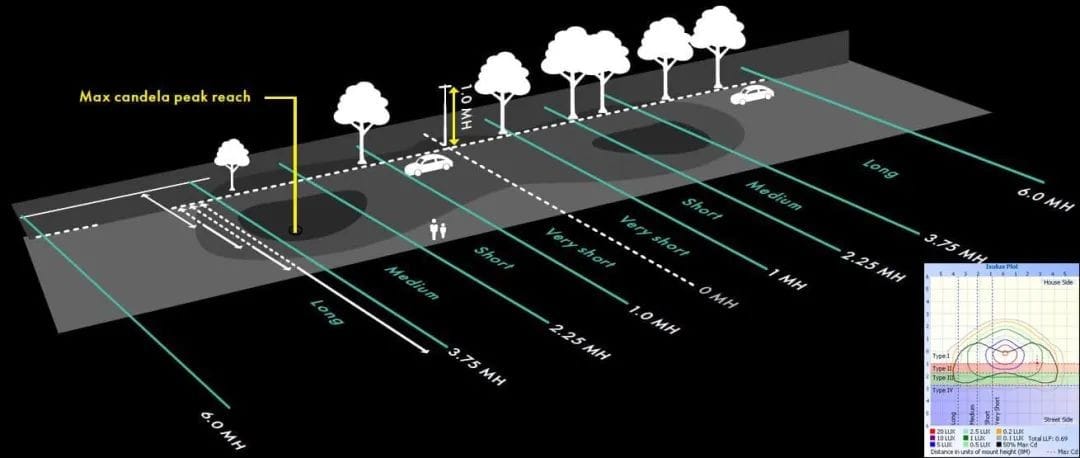
While the IESNA classifications are foundational, they serve more as guidelines rather than rigid rules. Their effective application requires consideration of numerous site-specific variables, underscoring the critical role of advanced lighting design tools and expert judgment in achieving optimal illumination. Several resources explicitly state that IESNA types are “guidelines” or “not fixed rules” and are influenced by factors like “fixture mounting height, tilt angle, arm length, and fixture-to-curb distance,” as well as “fixture layout and road conditions” 8. Documents also note the importance of “photometric data” and “modeling” in optimizing light distribution 15. The theoretical light distribution defined by IESNA types can change significantly due to specific installation parameters. For instance, incorrect mounting height or tilt angle may result in insufficient uniformity, excessive glare, or inefficient light distribution, even if the “correct” IESNA type is chosen. This complexity demands detailed photometric analysis and modeling, indicating that effective lighting design is an iterative and intricate process. It is not merely selecting a fixture type from a catalog. Designers must integrate theoretical knowledge (IESNA standards) with practical site conditions, validating their selections through advanced modeling tools. This emphasizes the value of expert lighting professionals in navigating these complexities to provide truly optimized and high-performance lighting solutions.
The IESNA system provides a solid framework for optimizing light coverage and pole spacing through its comprehensive classification of lateral and vertical light distribution. This dual classification directly contributes to improving energy efficiency and safety in roadway lighting projects. IESNA classifies light based on “lateral” (crossing the road, related to road width and coverage) and “vertical” (along the road direction, related to pole spacing) distribution 8. Lateral types (I-V/VS) match road widths (e.g., Type I for single lanes, Type II for double lanes, Type III for highways, Type V for large area lighting). Vertical types (S, M, L) correlate directly with “recommended pole spacing” and “pole height” 8. By precisely defining how light propagates laterally and vertically along the road, IESNA empowers designers to choose fixtures that minimize light overlap (wasting energy) and eliminate dark spots (affecting safety and visual comfort). For instance, opting for “long” vertical distribution can enable larger pole spacings, which can significantly reduce the number of poles and fixtures required for a given segment. This directly impacts initial installation costs and long-term energy consumption 8. Conversely, misjudging vertical distributions may lead to over-lighting or insufficient coverage between poles. The integration of lateral and vertical classifications allows for a highly optimized lighting design that is both functionally effective and resource-efficient. This optimization is crucial for achieving the goals outlined in standards like ANSI/IES RP-8-22, which include “minimizing energy use,” “enhancing driver visual quality,” and “providing high-quality light and increasing the visibility contrast of hazards” 18. It represents a systematic, scientific approach aimed at balancing lighting needs with economic feasibility, safety, and environmental impact.
5. Comparative Analysis and Design Considerations
Effective outdoor lighting design in North America reflects the complex interplay of various classification systems and optical characteristics. Understanding how cutoff fixtures, non-cutoff fixtures, batwing distributions, and IESNA classifications interact is crucial for developing optimal, compliant, and sustainable lighting solutions.
5.1. Interaction Between Cutoff Classifications and IESNA Types
Cutoff classifications (full cutoff, cutoff, semi-cutoff, non-cutoff) primarily control the amount of light emitted above the horizontal plane, serving as key mechanisms for controlling light pollution and glare 1. In contrast, IESNA types (I-V/VS) describe the shape and distribution of light on the ground, determining the effectiveness of illumination in areas such as roads or parking lots 8.
In contemporary North American street lighting, there is an overwhelming emphasis on using full cutoff fixtures. This preference is driven by stringent dark sky initiatives, environmental protection goals, and the desire to minimize light trespass and glare 5. These full cutoff fixtures are subsequently designed with specific IESNA lateral and vertical distributions (for example, full cutoff Type III medium distribution fixtures). The “cutoff” aspect ensures environmental responsibility by preventing light from spilling upwards, while the “IESNA type” ensures light is functionally directed and distributed to the target area (e.g., a multi-lane highway or large parking lot). These two systems work synergistically: cutoff addresses “where light should not go,” while IESNA addresses “where light should go and how it should be distributed.”
5.2. Integration of Batwing Distribution with IESNA Classifications
Batwing distribution itself is neither an IESNA classification nor a cutoff classification. Instead, it is a specialized optical design feature aimed at enhancing the “quality” and “uniformity” of light within the illuminated area 12. Its primary goal is to eliminate hotspots and provide a glare-free, comfortable lighting environment.
Batwing optical elements can be seamlessly integrated into fixtures with various IESNA distributions, particularly those designed for large-area coverage. For example, fixtures creating a symmetrical circular pattern (IESNA Type V) may be equipped with batwing optical elements 9. This combination creates a circular light pattern that is not only symmetrical but also exceptionally uniform without discomforting hotspots, making it highly suitable for areas requiring consistent lighting such as large plazas, central intersections, or open industrial spaces 9. Similarly, it may also be found in Type III distributions 23. This illustrates how batwing can serve as a qualitative enhancement within the quantitative framework of IESNA.
5.3. Comprehensive Considerations for North American Streetlight Projects
The selection of fixtures for streetlight projects in North America is a multidimensional optimization problem that necessitates a holistic approach balancing regulatory compliance (cutoff/BUG), functional requirements (IESNA lateral/vertical), and light quality (batwing, glare control), to achieve optimal safety, efficiency, and environmental management. This is seldom a singular, isolated choice.
Energy efficiency: Strategically selecting fixtures with appropriate cutoff classifications (especially full cutoff) and optimized IESNA types directly contributes to energy savings. By directing light precisely to the required areas and minimizing waste (uplight, backlight, spillover), overall energy consumption can be reduced 6. The widespread adoption of LED technology further enhances these efficiencies owing to its inherent design flexibility and higher lumen/watt output 9.
Visual comfort and safety: Minimizing glare and ensuring high illumination uniformity is crucial for visual comfort and safety. Proper cutoff fixtures can reduce discomfort glare for drivers and pedestrians, while appropriate IESNA types (potentially enhanced by batwing optical elements) ensure uniform light levels, reducing shadows and improving visibility of hazards 8. This directly correlates with reduced nighttime vehicle accident rates and increased pedestrian safety 18.
Dark sky initiatives and environmental impact: Adhering to full cutoff principles as well as guidelines from organizations like DarkSky International 7 and IES Recommended Practices (such as RP-33 Outdoor Environmental Lighting Recommended Practice) 5 is crucial for mitigating skyglow, protecting natural nightscapes, and preserving nocturnal ecosystems. This reflects a growing environmental awareness within lighting design.
Regulatory compliance: Local regulations, municipal codes, and state laws across North America often mandate specific cutoff classifications (e.g., full cutoff), and generally recommend or require various outdoor lighting applications to adhere to IESNA types 5. Compliance is not only a legal requirement but also a commitment to responsible urban development.
Economic benefits: In addition to environmental and safety advantages, optimized lighting design guided by IESNA standards and cutoff requirements can lead to significant economic benefits. This includes reduced initial installation costs (for example, by optimizing pole spacing with IESNA vertical types 8) as well as reduced long-term operating costs through energy savings 18. Moreover, well-lit areas can enhance public perceptions and potentially attract more foot traffic into commercial districts, boosting economic activity 18.
In practical applications, fixtures must meet multiple requirements: for example, they need to be “full cutoff” to comply with dark sky regulations and minimize light pollution 6; they must possess the appropriate IESNA lateral type (e.g., Type II or Type III) to effectively illuminate roads of specific widths 8; they should have the appropriate IESNA vertical type (e.g., medium or long) for optimal pole spacing along the road, ensuring uniformity and cost-effectiveness 8; and they might need to incorporate batwing optical elements to ensure surface light is evenly distributed without glare, enhancing visual comfort for users 12. Furthermore, all designs must comply with local municipal codes 5. This multifaceted requirement indicates that lighting designers cannot simply isolate one IESNA type. They have to consider the cutoff rating of the fixtures, their internal optical elements (such as batwing), and how these characteristics work together to meet the project’s various functional, environmental, regulatory, and aesthetic objectives. The complexity of finding fixtures that can simultaneously meet all these criteria often necessitates detailed photometric analysis and modeling tools 15. This highlights the critical role of expert consultation and comprehensive design processes in modern outdoor lighting.
6. Conclusion
Outdoor lighting design, particularly in North America, is a complex and nuanced field, centered on a profound understanding of various light distribution concepts. This article elucidates the fundamental distinctions between cutoff fixtures (full cutoff, cutoff, semi-cutoff), non-cutoff fixtures, and the specialized batwing distribution, providing a comprehensive comparison with the authoritative IESNA classification system for roadway lighting.
Cutoff classifications primarily serve as significant mechanisms for controlling light pollution and glare, where full cutoff fixtures represent the most stringent and environmentally friendly standards by directing all light downward. In contrast, non-cutoff fixtures significantly increase light trespass and skyglow due to the lack of such controls, resulting in their use becoming increasingly restricted. Batwing distribution differs from these broader classifications as it is an optical engineering solution focused on achieving exceptional uniformity and visual comfort within the illumination area, typically as a supplement to IESNA types for specific applications requiring hotspot-free lighting.
Ultimately, the best street lighting design in North America is a complex and comprehensive task. It requires integrating the precise, area-based distribution patterns specified by IESNA with strict cutoff requirements and, where appropriate, advanced optical solutions like batwing distribution. This integrated approach not only ensures functional lighting but also maximizes energy efficiency, enhances public safety and visual comfort, and maintains vital dark sky protection initiatives. Guiding the informed selection and professional design of fixtures under these integrated standards and considerations is crucial for creating sustainable, compliant, and high-quality outdoor lighting environments for communities.

